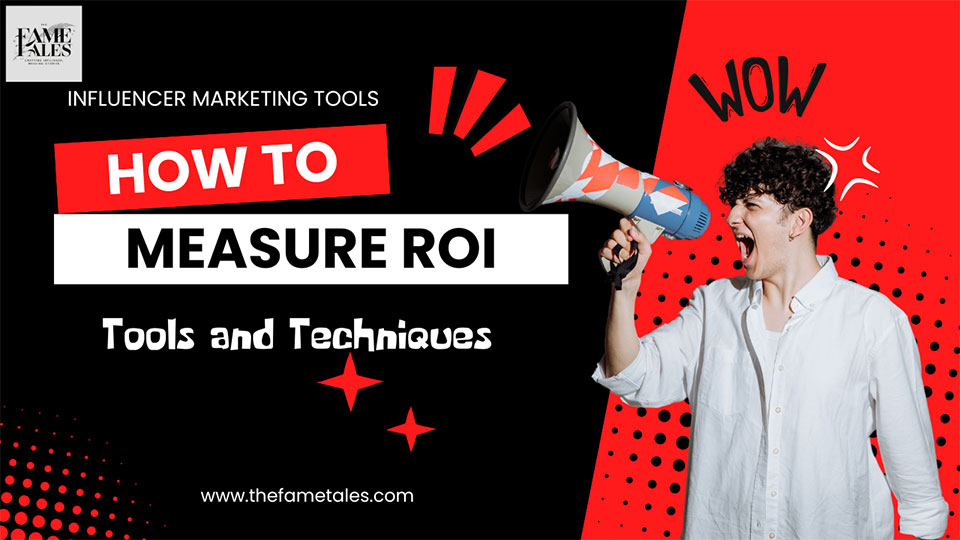How to Measure ROI in Influencer Marketing: Tools and Techniques

Introduction
In the dynamic world of influencer marketing, measuring return on investment (ROI) is essential for assessing the effectiveness and success of your campaigns. However, determining ROI in influencer marketing can be complex due to various factors such as engagement, brand awareness, and conversion rates. In this blog, we explore effective tools and techniques for measuring ROI in influencer marketing, empowering brands to optimize their strategies and maximize results.
Understanding ROI in Influencer Marketing
ROI in influencer marketing refers to the value generated from your investment in collaborating with influencers to promote your brand or products. It encompasses both tangible and intangible benefits, including increased brand awareness, engagement, website traffic, and ultimately, conversions and sales.
Benefits of Measuring ROI in Influencer Marketing
Measuring ROI in influencer marketing offers several benefits:
- Performance Evaluation: Assess the effectiveness of your influencer campaigns and identify areas for improvement.
- Resource Allocation: Allocate budget and resources more effectively by focusing on strategies that deliver the highest ROI.
- Optimization Opportunities: Optimize influencer partnerships and content strategies based on data-driven insights.
- Demonstrate Value: Provide stakeholders with tangible evidence of the impact and value of influencer marketing efforts.
- Enhanced Decision-Making: Make informed decisions about future campaigns and investments to achieve better outcomes.
Tools for Measuring ROI in Influencer Marketing
1. Influencer Marketing Platforms
- Platforms like Hootsuite, AspireIQ, and Upfluence offer comprehensive analytics and reporting tools to track the performance of influencer campaigns.
- Features may include audience demographics, engagement metrics, reach, impressions, and conversion tracking.
2. Google Analytics
- Utilize Google Analytics to track website traffic, referral sources, and conversion rates driven by influencer campaigns.
- Set up UTM parameters to attribute traffic and conversions to specific influencer links or campaigns.
3. Social Media Analytics Tools
- Platforms like Instagram Insights, Facebook Analytics, and Twitter Analytics provide valuable data on post reach, engagement, and audience demographics.
- Use these insights to evaluate the impact of influencer content on social media platforms.
4. Affiliate Marketing Platforms
- Affiliate marketing platforms such as ShareASale and Commission Junction enable you to create customized affiliate links for influencers.
- Track affiliate sales and commissions generated by influencer-driven traffic to measure ROI accurately.
5. Brand Mentions and Sentiment Analysis Tools
- Monitor brand mentions and sentiment across social media platforms using tools like Brandwatch and Mention.
- Analyze audience sentiment and perception of your brand to gauge the effectiveness of influencer campaigns.
Techniques for Measuring ROI in Influencer Marketing
1. Trackable Links and Promo Codes
- Provide influencers with unique trackable links or promo codes to include in their content.
- Monitor the performance of these links or codes to attribute website traffic and conversions directly to influencer campaigns.
2. Engagement Metrics
- Analyze engagement metrics such as likes, comments, shares, and saves on influencer posts.
- Higher engagement rates indicate increased brand visibility, audience interest, and potential for conversion.
3. Conversion Tracking
- Implement conversion tracking pixels or tags on your website to track user actions, such as purchases or sign-ups, originating from influencer-driven traffic.
- Attribute conversions to specific influencer campaigns to measure their impact on sales or lead generation.
4. Brand Lift Studies
- Conduct brand lift studies or surveys to measure changes in brand awareness, perception, and sentiment before and after influencer campaigns.
- Assess the influence of influencer content on brand perception and consumer behavior.
5. Lifetime Value (LTV) Analysis
- Calculate the lifetime value of customers acquired through influencer marketing efforts.
- Compare the LTV of influencer-acquired customers with other acquisition channels to evaluate the long-term impact and ROI of influencer campaigns.
Conclusion
Measuring ROI in influencer marketing is crucial for evaluating performance, optimizing strategies, and demonstrating the value of your investment. By leveraging tools and techniques such as influencer marketing platforms, Google Analytics, trackable links, and engagement metrics, brands can gain valuable insights into the effectiveness of their influencer campaigns.
As the influencer marketing landscape continues to evolve, it's essential to adopt a data-driven approach to measuring ROI and refining your strategies accordingly. By harnessing the power of analytics and leveraging the right tools, brands can unlock the full potential of influencer marketing and achieve tangible business results.
Remember, measuring ROI is not just about quantifying financial returns but also understanding the holistic impact of influencer marketing on brand awareness, engagement, and customer relationships. By continuously evaluating and optimizing your influencer marketing efforts, you can drive sustainable growth and success for your brand in the ever-changing digital landscape.
Other Blog
- Influencer Marketing for Small Businesses: Tips and Tricks
- The Impact of Gen Z on Influencer Marketing Strategies
- How to Find the Right Influencers for Your Brand in 2024
- The Rise of Micro-Influencers in 2024: Why Smaller is Bigger
- How to Measure ROI in Influencer Marketing: Tools and Techniques
- The Benefits of Long-Term Influencer Partnerships
- How to Use Influencer Marketing for Product Launches
- The Ethics of Influencer Marketing: What Brands Need to Know
- How to Avoid Common Pitfalls in Influencer Marketing Campaigns
- The Future of Influencer Marketing: Predictions for the Next 5 Years
Related Blogs

Influencer Marketing for Small Businesses: Tips and Tricks

The Impact of Gen Z on Influencer Marketing Strategies

How to Find the Right Influencers for Your Brand in 2024

The Rise of Micro-Influencers in 2024: Why Smaller is Bigger

How to Measure ROI in Influencer Marketing: Tools and Techniques

The Benefits of Long-Term Influencer Partnerships

How to Use Influencer Marketing for Product Launches

The Ethics of Influencer Marketing: What Brands Need to Know

How to Avoid Common Pitfalls in Influencer Marketing Campaigns

